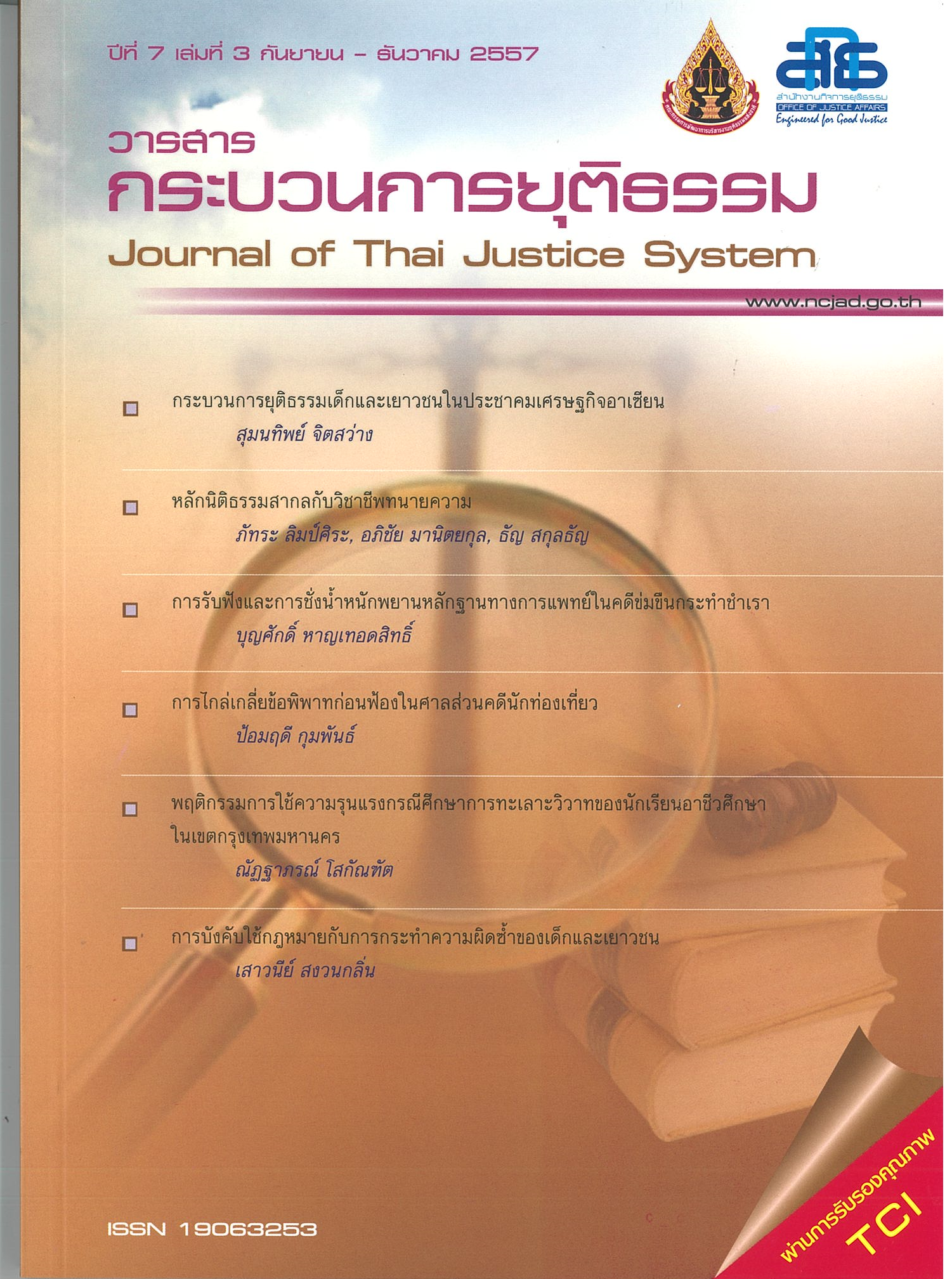พฤติกรรมการใช้ความรุนแรงกรณีศึกษาการทะเลาะวิวาทของนักเรียนอาชีวศึกษาในเขตกรุงเทพมหานคร
Main Article Content
บทคัดย่อ
การวิจัยครั้งนี้มีวัตถุประสงค์เพื่อศึกษาปัจจัยด้านจิตวิทยา ครอบครัวและชุมชน การคบเพื่อนที่กระทำผิดและปัจจัยค่านิยมการใช้การความรุนแรงในสถาบันมีความสัมพันธ์กับระดับพฤติกรรมการใช้ความรุนแรง และเปรียบเทียบระดับพฤติกรรมการใช้ความรุนแรงของสถาบันอาชีวศึกษาถาครัฐและเอกชน ซึ่งเป็นการวิจัยเชิงปริมาน โดยใช้แบบสอบถามกับนักเรียนนักศึกษาอาชีวศึกษาที่มีหรือเคยมีพฤติกรรมการใช้ความรุนแรง ในการทะเลาะวิวาท จำนวน 400 คน และวิเคราะห์ข้อมูลโดยใช้สถิติการแจงค่าความถี่ ค่าอัตราส่วนร้อยละค่าเฉลี่ยเลขคณิต ค่าส่วนเบี่ยงเบนมาตรฐานการวิเคราะห์เปรียบเทียบ (Independent T-test) และการวิเคราะห์ถดถอยพหุแบบเชิงชั้น (Hierarchical multiple regressionanalysis)
ผลการวิจัยพบว่า ปัจจัยที่สัมพันธ์และสามารถพยากรณ์ระดับพฤติกรรมการใช้ความรุนแรง ได้แก่ ปัจจัยด้านจิตวิทยา ปัจจัยด้านการคบเพื่อนที่กระทำผิด โดยวิเคราะห์ผ่านปัจจัยค่านิยมการวช้ความรุนแรงในสถาบันซึ่งส่งผลทำให้ปัจจัยทั้ง 2 ด้านนี้มีความสัมพันธ์ทั้งทางตรงและทางอ้อมกับพฤติกรรมการใช้ความรุนแรง ส่วนปัจจัยด้านครอบครัวและชุมชน
เมื่อนำมาวิเคราะห์นั้นพบว่า มีความสัมพันธ์กับพฤติกรรมการใช้ความรุนแรงแต่เมื่อนำมาวิเคราะห์ผ่านปัจจัยค่านิยมการใช้ความรุนแรงในสถาบัน นั้นพบว่า ปัจจัยด้านครอบครัวและชุมชนไม่มีความสัมพันธ์ทางตรงแต่มีความสัมพันธ์ทางอ้อมกับพฤติกรรมการใช้ความรุนแรงกรณีศึกษาการทะเลาะวิวาทได้ร้อย 57.3 จากการศึกษาระดับพฤติกรรมการใช้ความรุนแรง พบว่าอยู่ในระดับปานกลาง (=2.77) และจากการศึกษาเปรียบเทียบระดับพฤติกรรมการใช้ความรุนแรงของสถาบันอาชีวศึกษาภาครัฐและเอกชน พบว่า ค่า p มีค่า 0.58 (มากกว่า 0.05) ระดับพฤติกรรมการใช้ความรุนแรงในสถานศึกษาอาชีวศึกษาสังกัดรัฐบาล (= 2.73) และเอกชน (= 2.78) จึงไม่มีความแตกต่าง
Article Details
ต้นฉบับที่ได้รับการตีพิมพ์ในวารสาร เป็นลิขสิทธิ์ของวารสารกระบวนการยุติธรรม แต่ความคิดเห็นที่ปรากฏในเนื้อหาของบทความในวารสารกระบวนการยุติธรรม ถือเป็นความรับผิดชอบของผู้เขียนแต่เพียงผู้เดียว
เอกสารอ้างอิง
จิรพัฒน์ พรหมสิทธิการ. (2543). ปัจจัยที่มีผลต่อการทะเลาะวิวาทของนักเรียนอาชีวศึกษา: ศึกษา กรณีเฉพาะในเขตกรุงเทพมหานครและปริมณฑล. วิทยานิพนธ์ ปริญญาศิลปะศาสตรมหาบัณฑิต, มหาวิทยาลัยเกษตรศาสตร์.
เฉลย คงปรีพันธ์. (2544). ปัญหาและมาตรการป้องกันแก้ไขการทะเลาะวิวาทของนักศึกษากลุ่มช่างอุตสาหกรรม สถาบันเทคโนโลยีราชมงคลในเขตกรุงเทพมหานครและปริมณฑล. วิทยานิพนธ์ปริญญาครุศาสตร์ อุสาหกรรมมหาบัณฑิต, สถาบันเทคโนโลยีพระจอมเกล้าเจ้าคุณทหารลาดกระบัง.
ชาญคณิต กฤตยา สุริยะมณี. (2554). ทฤษฎีอาชญาวิทยาร่วมสมัยกับการวิจัยทางด้านอาชญาวิทยา ในปัจจุบัน. นนทบุรี: หยินหยางการพิมพ์.
ณัฎฐนิช การญจโนภาส. (2550). การเสพติดเกม. วิทยานิพนธ์ปริญญาศิลปศาสตรมหาบัณฑิต, มหาวิทยาลัยมหิดล.
ทิพยวรรณ กิตติพร. (2550). จิตวิทยาทั่วไป (พิมพ์ครั้งที่ 4). พิษณุโลก: มหาวิทยาลัยนเรศวร.
ธิติมา เก่งถนอมศักดิ์. (2546). สาเหตุการทะเลาะวิวาทของนักเรียนในเขตกรุงเทพมหานคร. วิทยานิพนธ์ปริญญาศิลปศาสตรมหาบัณฑิต, มหาวิทยาลัยเกษตรศาสตร์.
มหาวิทยาลัยราชภัฎสวนดุสิต. (2549). การศึกษาสาเหตุและแนวทางการแก้ปัญหาการทะเลาะวิวาท ของนักเรียนอาชีวศึกษาเอกชน. กรุงเทพมหานคร.
ยิ่งภัสสร พิมพิสัย. (2555). ศึกษาสภาพปัญหาและแนวทางแก้ไขการทะเลาะวิวาทของนักเรียน อาชีวศึกษา ในเขตกรุงเทพมหานครและปริมณฑล. วิทยาลัยเทคนิคดอนเมือง.
รุจิราพร หงส์ทอง. (2550). การจัดทำฐานข้อมูลสารสนเทศภูมิศาสตร์เพื่อการเฝ้าระวังและเตือนเหตุการณ์ทะเลาะวิวาทของนักเรียนระดับอาชีวศึกษา เขตมีนบุรี กรุงเทพมหานคร.
วัชรพันธ์ ประดิษฐพงษ์. (2544). การก่อเหตุทะเลาะวิวาททำร้ายร่างกายของนักเรียนในพื้นที่กองบังคับการจำรวจนครบาล 7. วิทยานิพนธ์สังคมศษสตรมหาบัณฑิต, มหาวิทยาลัยะรรมศาสตร์.
วันเดิม มีความดี. (2546). ปัจจัยที่มีผลต่อการทะเลาะวิวาทของนักเรียนอาชีวศึกษาประเภทช่าง อุตสาหกรรมในเขตกรุงเทพมหานครและปริมณฑล. วิทยานิพนธ์ปริญญาครุศาสตรมหาบัณฑิต, สถาบันราชภัฎเพชรบุรีวิทยาลงกรณ์ในพระบรมราชูปถัมภ์.
วิโรจน์ อารีย์กุล. (ม.ป.ป.). พัฒนาการทางด้านสังคมจิตวิทยาของวัยรุ่น. ค้นเมื่อ 15 กนัยายน 2556. จาก http://www.teenrama.com/dad_mam/old_dad_mam24.htm
สำนักงานตำรวจแห่งชาติ. (2555). มาตรการของเจ้าหน้าที่ตำรวจและมาตรการทางสังคมกับการ แก้ไขปัญหาการทะเลาะวิวาทของนักเรียน/นักศึกษาต่างสถาบัน.กรุงเทพมหานคร. ผุ้แต่ง.
สุณีย์ กัลยะจิตร. (2556). ปัญหาการกระทำผิดของเด็กและเยาวชน: แนวทางการป้องกันและการแก้ไข. กรุงเทพมหานคร: สินทวีพริ้นติ้ง.
เสน่ เสถียรพงศ์. (2540). การก่อเหตุทะเลาะวิวาททำร้ายร่างกายของนักเรียนอาชีวศึกษาในเขตกรุงเทพมหานครและปริมณฑล. วิทยานิพนธ์ปริญญาศิลปศาสตรมหาบัณฑิต,มหาวิทยาลัยธรรมศาสตร์.
โสภัณฑ์ นุชนารถ. (ม.ป.ป.). ค่านิยม (value). กรุงเทพมหานคร: มหาวิทยาลัยราชภัฎธนบุรี, คณะครุศาสตร์.
อัจฉรา ทองตัน. (2536). การกระทำผิดของเด็กและเยาวชนในประเทศไทย. วิทยานิพนธ์ปริญญาสังคมศาสตรมหาบัณฑิต, มหาวิทยาลัยมหิดล.
อุษารัตน์ นิติยารมย์. (2548). กระทรวงศึกษาธิการกับการจัดการแก้ไขปัญหาทะเลาะวิวาทของ นักเรียนอาชีวศึกษา. วิทยานิพนธ์ปริญญาศิลปศาสตรมหาบัณฑิต, มหาวิทยาลัยรามคำแหง.
Cloward, R., & Ohlin, L. (1961). Delinquency and opportunity. New York: Free Press. Cullen, F.T., & Agnew, R. (2003). Criminological theory: Past to present essential readings (2nd ed). Los Angeles: Roxbury Press.
Glaser. (1967). Strauss the discovery of grounded theory. Chicago, II: Aldine Publishing.
Hirschi, T. (1969). Causes of delinquency. Berkeley, University of California Press.
Schrag, C. (1971). Crime and justice: American style. Washington, DC: Government Printing office.
Shelley, J. F. (2000). Criminology (3rd ed.). California: Wadsworth.
Shoemaker, D.J. (1990). Theories of delinquency: An examination of explanations of delinquency behavior (2nd ed.). New York: Oxford University Press.
Siegle, L.J. (2000). Criminology (7th ed.). California: Wadsworth Thomason Learning.


